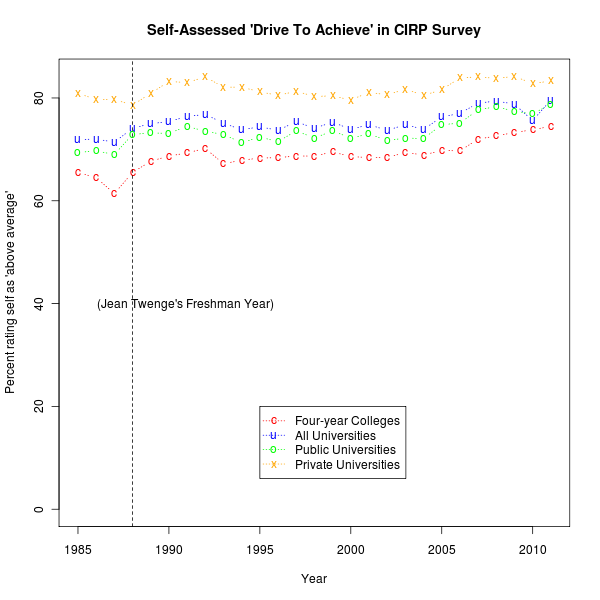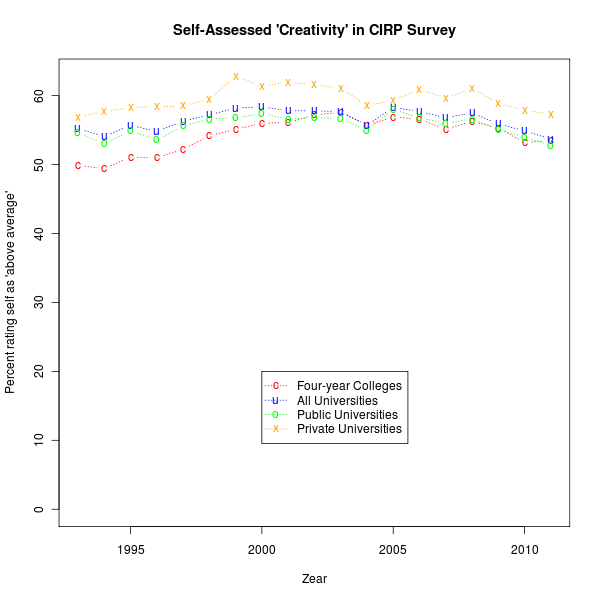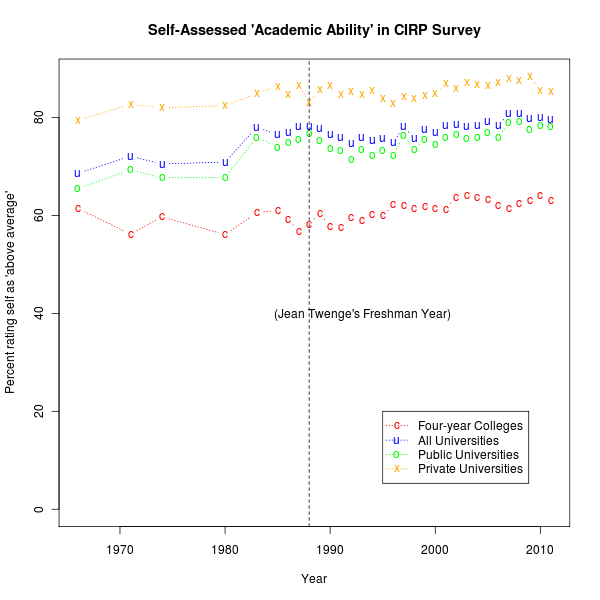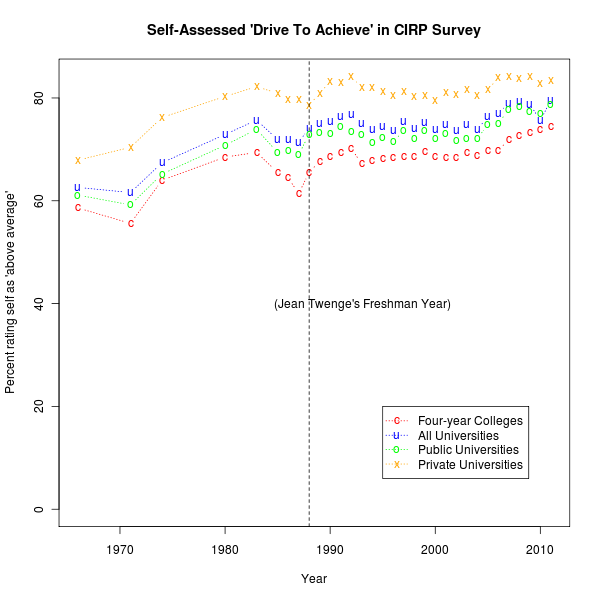"… a generation of deluded narcissists"?
« previous post | next post »
Keith Ablow, "We are raising a generation of deluded narcissists", Fox News 1/8/2013:
A new analysis of the American Freshman Survey, which has accumulated data for the past 47 years from 9 million young adults, reveals that college students are more likely than ever to call themselves gifted and driven to succeed, even though their test scores and time spent studying are decreasing.
Psychologist Jean Twenge, the lead author of the analysis, is also the author of a study showing that the tendency toward narcissism in students is up 30 percent in the last thirty-odd years. This data is not unexpected. I have been writing a great deal over the past few years about the toxic psychological impact of media and technology on children, adolescents and young adults, particularly as it regards turning them into faux celebrities—the equivalent of lead actors in their own fictionalized life stories.
The "American Freshman Survey" under discussion is the CIRP Freshman Survey, and indeed, 46 years of detailed reports on its results are available, though as far as I can tell, the tabulation of student self-assessments has only been regularly published since 1985. Still, 26 years should allow us to see the trend — it includes, for instance, Jean Twenge's own college class, which matriculated in the fall of 1988.
Here's a plot showing the percentage of freshmen who self-assess as "above average" or "top 10%" in "Academic Ability", for each year since 1985:
In my opinion, the alleged trend in this plot is even more underwhelming than the evidence from "individualistic" vs. "communal" words in published works was — for some discussion, see "Textual narcissism", 7/13/2012, "Textual narcissism, replication 2", 7/14/2012, and "What does this graph mean?", 7/15/2012.
Here's the plot for the "Drive to Achieve" question:
There seems to be a modest narrowing of the differences among types of institutions, but again, not that much of an overall trend. (And why would having a higher self-assessed "drive to achieve" be a sign of narcissism, anyhow?)
"Creativity" has only been included in the questionnaires since 1993, and self-assessments of creativity should be a good place to look for "deluded narcissists", since this is not a characteristic for which students get any quantitative feedback — but again, first-year students' self-assessments of creativity, over the past 18 years, hardly show an explosion of narcissism:
There does appear to be a generation of deluded narcissists here: that is, a cohort of people who are so wrapped up in their own belief systems that they're unable to see the facts of the world around them. But the evidence suggests that such people are less common in recent freshman classes than among 50-ish pundits.
Update: From 1985 on, CIRP has reported "Academic Achievement" and "Drive to Achieve" self-assessments every year. Before 1985, I could only find results for 1966, 1971, 1975, 1980, and 1983. Because the way that the CIRP reports described these results in the pre-1985 period, I falsely concluded that the questions had been asked differently then. Steve Kass (below) found scans of the questionnaires on the CIRP website, and shows that this is wrong.
So here are plots including all the CIRP dates I could find. The plot for "Academic Ability" doesn't really change the picture very much, although we see a narrowing of the gap between public and private universities:
The "Drive to Achieve" numbers do seem to show a pre-1983 rise:
But whatever factors were changing this measure — a genuine underlying change in attitudes; changes in student demographics; changes in the way the results are normed — they seem to have affected a generation of students who are now roughly 45-65 years old. Hardly "Kids Today".





Jason Eisner said,
January 13, 2013 @ 10:42 pm
If I understand correctly, the survey wording that you quote asks the freshmen at 4-year colleges and universities to compare themselves with the average person of their age.
Such freshmen might accurately believe themselves to have above-average academic ability for their age. People with below-average academic ability are less likely to go to college in the first place.
(Less than half of the U.S. population born in a given year enrolls in "college" as a "recent" high school graduate, according to http://www.ncbi.nlm.nih.gov/pmc/articles/PMC2900934/figure/F5/ , although I am not sure how they define the quoted terms.)
[(myl) Of course. There's no reason to think that the self-comparisons are not roughly accurate. If it were really true that there was a massive inflation in self-assessments over the past few decades, this might indicate a change in accuracy, since the proportion of kids attending college has generally gone up during that period. But in fact, the self-assessments have been fairly stable.]
Jason Eisner said,
January 13, 2013 @ 10:44 pm
I saw another graph derived from this survey at http://www.bbc.co.uk/news/magazine-20756247 . Again, I had trouble seeing the narcissism, even on my assumption at the time that the "peers" against which the respondents were judging themselves were other college students.
On 3 of the 5 criteria shown, including writing ability, the 2009 students were actually measuring themselves more accurately against their peers than the 1966 students had. For example, the graph shows that in 1966, students used to underestimate their writing ability: only 30% thought they were above average. In 2009 about 50% thought they was above average, which was presumably about right!
(Of course no one is happy if actual writing quality has gone down, or if the students think that poor writing is "good enough." But those issues are orthogonal to the "narcissism" issue of how students rank themselves within their cohort.)
Jason Eisner said,
January 13, 2013 @ 10:48 pm
And another hopeful sign is that while I committed multiple agreement errors in the posts above, at least I'm not too narcissistic to notice them. :-)
Steve Kass said,
January 13, 2013 @ 11:04 pm
[Short version] "What you said."
[Long version] This graph appears in the BBC's and other reports of this "new analysis of the American Freshman Survey." (Any actual analysis itself, however, is elusive, though a November audio interview with Twenge (fast forward to its start at 12:37) refers to one – the same one? – as "a new paper just published" [at 13:01]. Where?)
The Twenge et al. graph shows pretty clearly, as your graphs do, that there's been little change in any of the five factors charted in the last 25 years, though before that, there was an upward trend – as you point out, right about up to Twenge's generation, and shown from further back in time here.
What's "new" about the current analysis escapes me. HERI published its own extensive 40-year analysis in 2006. Table 5 of that report gives three data points for a selection of self-rating questions that overlaps the ones in the graph Twenge provided to the BBC, and they noted that the most significant increases were not in the most recent two decades.
Twenge's analysis omits exactly two self-rating categories with no missing data in HERI's Table 5: the two that least support Twenge's thesis: "academic ability" and "mathematical ability." Both of them showed much smaller increases than the categories Twenge charted.
I'm not sure where you found the 1983 and 1985 reports (where "Above Average" became "Above Average or Highest 10%"), but the question seems to have been asked the same way each year (see questionnaires here). If the reports are precisely described, the pre-1985 omission of one category of answers could explain some of the lower numbers on the left side of Twenge's graph. However, Table 5 of the HERI 40-year report uses the description "Above Average or Highest 10%" for 1966, suggesting that the same measure has been used across time.
Scott Angell said,
January 14, 2013 @ 12:51 am
Another interesting (and entertaining) article on the subject (better than Ablow's, anyway):
http://thelastpsychiatrist.com/2011/08/grade_inflation.html
Shane said,
January 14, 2013 @ 12:56 am
Yes. Well-trained by a few preceding generations of deluded narcissists.
Frans said,
January 14, 2013 @ 4:27 am
@Jason
Indeed. I don't know about the US, but attending university over here* puts you in the top 10-15% of "academic ability" by definition, or you wouldn't get in. Everybody going to college is similarly in the top 50-60% by definition.
* Belgium, Germany, the Netherlands, and probably France too.
[(myl) The proportion of the population attending post-secondary educational institutions in the U.S. is indeed larger than in Europe. But as I noted in responding to Jason Eisner, the "evidence" for the "narcissism" of kids today would NOT be a relatively high self-estimate of where their abilities stand in relation to their peers (whatever rhetorical use might be made of this), but rather a meaningful INCREASE in this self-estimate, over a time period during which the proportion in post-secondary education has increased or at least remained stable. But if there was any such increase, it took place among people who are now in late middle age.]
Frans said,
January 14, 2013 @ 6:37 am
@myl
If college is a catch-all term for post-secondary educational institutions then the percentages I gave are incorrect. There are three primary subdivisions in that regard, namely university (15%), "high school" (what i translated as college, about 40-50% bringing the total to the aforementioned 50-60%), and intermediate vocational education (another 40% or so). I was under the impression that the latter was also called "vocational school" in the US rather than college.
[(myl) I don't think it's easy to make comparisons between the U.S. and Europe, since both the realities and the terminologies are quite different. (For example, the category of "four-year colleges" includes some of the most elite and selective post-secondary institutions in the U.S., as well as many that are less selective.) According to this, "In October 2011, 68.3 percent of 2011 high school graduates were enrolled in colleges or universities". This includes all 4,495 degree-granting post-secondary institutions — 2,774 four-year institutions and 1,721 2-year institutions, according to a Wikipedia article, which also provides some useful terminological discussion.
This report tells us that "In fall 2009, Title IV institutions in the United States enrolled a total of 21 million undergraduate and graduate students; 62 percent were enrolled in 4-year institutions, 37 percent were enrolled in 2-year institutions, and 2 percent were enrolled in less-than-2-year institutions". Here's a table with more information than you could possibly want.
In the plots above, I've included data from the categories of "four-year colleges" and "universities".]
Adrian said,
January 14, 2013 @ 10:02 am
I'm a bit confused about the graph – there is a line for "four year colleges" that is very distinct from universities in most of the graphs. What is the difference between four year college and university? As far as I know, they're academically equivalent in the U.S.
[(myl) As the CIRP reports explain, they assume that "universities are those institutions defined by 2005 Basic Carnegie Classification as 'research universities' or 'doctoral/research universities'"; "four-year colleges" are then those institutions offering 4-year BA or BS degrees that are not "universities".]
Rube said,
January 14, 2013 @ 10:42 am
"And why would having a higher self-assessed "drive to achieve" be a sign of narcissism, anyhow"
Yeah, that's a real heads-I-win, tails-you-lose, since not reporting a high drive to achieve would indicate that you're a narcissist who expects everything to be handed to you.
J.W. Brewer said,
January 14, 2013 @ 10:59 am
According to the linked wikibio, Dr. Ablow believes in "immeasurable and powerful spiritual and psychological forces that connect all of us—one to another." Perhaps "immeasurable" means he is not impressed by your scientistic attempts to contradict his impressionistic sense of the world with arguments grounded in quantitative data?
I also see that Dr. Ablow (a few years older than myself, but just enough to make him, unlike me, a Baby Boomer, and thus of course stereotypically narcissistic) seems to have himself been in the exact same cohort of American college freshmen (those who matriculated fall '79) as our current President, who has been defended at this site from linguistically-based charges of narcissism. So even if the born-in-'61 cohort was unusually prone to narcissism as an overall statistical tendency, case-by-case evaluation of individuals may still be appropriate.
D.O. said,
January 14, 2013 @ 12:03 pm
Well, if college attendance among recent HS graduates is up, even the stable percentages among college students might mean an upward trend in self-esteem. But I have too low academic ability and drive to achieve to dig out and analyze actual data.
Frans said,
January 14, 2013 @ 2:41 pm
@myl
Thank you, that was enlightening. It would seem the categories are defined much more clearly over here, to some extent even EU-wide since the late 1990s.
Jonathan Mayhew said,
January 14, 2013 @ 9:37 pm
We (or the culture generally) push self-esteem, creativity, and achievement but then denigrate kids who want to be creative and achieve something. That is the classic "double bind" or "heads I win tails you lose."
Tony said,
January 14, 2013 @ 11:58 pm
@Rube
My take on it is that to think oneself driven/diligent/industrious is a form of narcissism. I think this is where the decrease in time spent studying comes into the picture.
Speaking of, though, I suspect the enormous increase in studying and learning efficiency afforded by electronic resources cannot be ignored when deciding that decreased time spent studying is a sign of decreased industry.
Robin said,
January 15, 2013 @ 3:12 am
And if more students had described themselves as NOT driven to achieve, journalists would lament that we're raising a generation of apathetic slackers. Kids these days!
Alex Blaze said,
January 15, 2013 @ 8:05 am
1. Ablow/Fox's editor used "data are." Clearly these people are smarter than everyone else.
2. Ablow is wrong when it comes to achievement – there's been a steady upward trend in NAEP scores (the test education experts call the "gold standard" in measuring academic achievement) over the last several decades.
3. Wonder why young people don't vote Republican! It's such a fucking mystery.
The Life Goals of Kids These Days | The Trait-State Continuum said,
January 16, 2013 @ 4:54 pm
[…] folks at the Language Log did a nice job of considering some recent claims about the narcissism and delusions of today’s […]